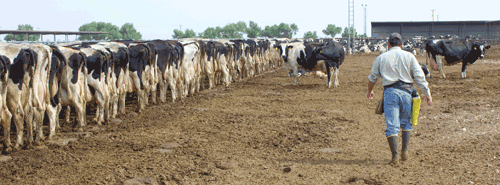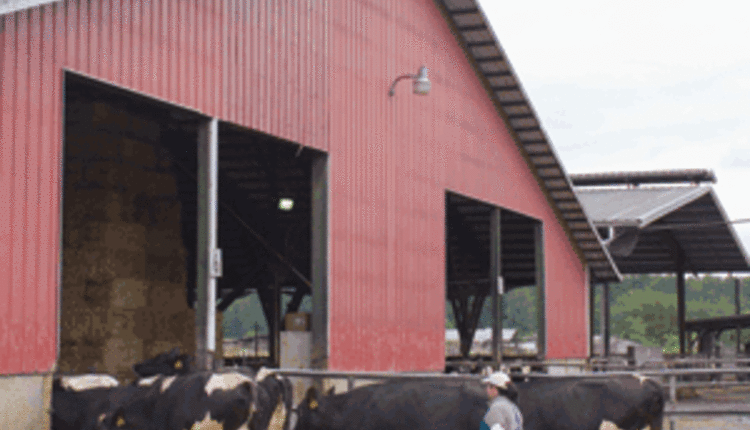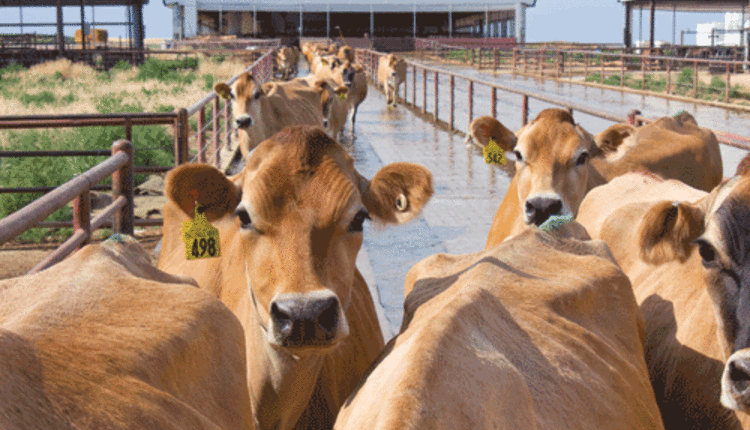Thomas is an author of many livestock books and owns a beef cattle herd with her husband in Salmon, Idaho. She wrote this series with Paul Rapnicki, D.V.M., formerly with the University of Minnesota School of Veterinary Medicine (UMN-SVM); Don Höglund, D.V.M., currently with the UMN-SVM; and Margaret Perala, D.V.M., with Vet Services of Deerfield, Kan.

All too often when a cow does not behave the way we want her to, we blame the cow instead of ourselves, but cattle react to human actions. Ideally, we want our cows to respond to what we ask them to do - walk calmly into the milking parlor, milk easily, go readily through a gate without running off, load willingly into a truck and so on.

All too often when a cow does not behave the way we want her to, we blame the cow instead of ourselves, but cattle react to human actions. Ideally, we want our cows to respond to what we ask them to do - walk calmly into the milking parlor, milk easily, go readily through a gate without running off, load willingly into a truck and so on.
Every time we handle cattle we are positively or negatively setting the stage for how they'll react to human handling in the future. They have excellent memories; therefore, a negative experience can have lasting repercussions.
Low-stress handling has become the popular term, but this strategy has ramifications far beyond conceptual understanding of the philosophy involved. Calm, relaxed cows produce more milk. Stressed cattle can be a danger to themselves and their handlers. Improper handling of cattle also opens the door to adverse public opinion regarding food animal production and plays into the hands of special interests such as animal rights groups that want to ban the raising of animals for human use.
The goal of everyone on the farm is to maximize production of wholesome food. One of the most important routes to that goal is humane and conscientious handling of the cattle - in every phase - from conception to table.
What do we know about behavior?
Human understanding of cattle behavior has gradually evolved over the past several decades. Science has examined the basics of natural behavior and verified some of the premises that good stockmen have utilized over centuries of cattle handling. Some of the primitive societies that depended on cattle for their lives and livelihood understood the human/cattle relationship. Even today, in some cultures, young children are in charge of taking the herds to and from grazing areas daily - controlling cattle very easily on foot. Our modern society has generally lost touch with how to interact with livestock. Dairy stockmanship is simply a rediscovery of the basic, simple truths of low-stress ways to influence cattle behavior.
One of the pioneers of modern science's examination of animal and human behavior was the psychologist, Dr. B. F. Skinner. His view of behavior analysis focused on behavior as a subject matter in its own right - a natural phenomenon - rather than as a manifestation of something happening in the brain or mind. In other words, cattle (as prey animals) have natural reactions to the environment around them and react in predictable ways to certain stimuli. We humans tend to assume that cattle react because they are afraid or think something will hurt them. We tend to attribute behavior to a mental cause rather than accepting it as a natural reaction to what we do when we are working with them.
If we can overcome this way of thinking and realize that cattle are simply reacting to our actions, we can take a closer look at our actions and deliberately change the way we handle cattle. If we let the cow determine how we act (by evaluating where she is and what she is doing), we can effectively control her behavior by providing the proper stimulus for the correct (desired) reaction.
The cow is always right
Skinner's view of behavior as a natural phenomenon gives us a starting point for accepting that the "cow is always right" and that we need to work with her natural behavioral reactions - rather than against them - in order to manipulate her actions. Stimulation, to create movement, is generally referred to as pressure. If we want her to move a certain direction, we create pressure on her personal space (often called the flight zone). When a person encroaches upon that personal space, the animal reacts by leaving (as it would if a predator approached).
The science of behavior analysis teaches us that all behavior in animals is a product of biological variables (species evolutionary history) and environmental variables, including both the present and past environment (prior experiences of that animal). Prey animals, including cattle, evolved with survival tactics like keeping an eye on anything that approaches, listening for danger sounds, and moving away if an approaching creature gets too close.
Improving human/animal interactions
Bud Williams, a stockman who now resides at Independence, Kan., has been a leader in teaching low-stress handling concepts to beef producers around the world for more than 30 years. His methods apply equally well to handling dairy cattle. In the past several years, the University of Minnesota's College of Veterinary Medicine has taken a strong interest in improving dairy stockmanship. Veterinarians Paul Rapnicki, Margaret Perala and Don Höglund attended the stockmanship schools taught by Bud Williams, seeking to improve their personal handling skills with dairy cattle.
This goal eventually expanded into a firm commitment to implement dairy stockmanship methods on commercial dairy operations. These three veterinarians now provide live-course training for people interested in improving their cattle handling methods. Low-stress handling techniques always improve the working relationship between cattle and humans, resulting in a much more satisfactory outcome for both.
Dairy veterinarians are often involved in helping dairy owners and their employees with training programs for dairy workers. The long-term goal for Minnesota's College of Veterinary Medicine dairy stockmanship program is to develop useful training resources for dairy veterinarians - to help improve their own stockmanship skills as well as to facilitate on-farm training with dairy clients. A research program is also being developed to study cow behavior responses to stockmanship techniques.
This is an opportunity to improve the handling skills of people who work with the cattle. Dairy workers are sometimes frustrated by uncooperative behavior of cattle, and the cattle are stimulated into negative behavior by the inexperience or poor techniques of the handlers. Most of our human tendencies in handling cattle are counterproductive because we don't pay enough attention to the cow and what she is telling us. Our actions should always be dictated by what that particular cow (or herd) perceives and how she (they) will react to our actions. Many of the habitual ways we handle cattle are inefficient and potentially unsafe.
A unique feature of dairy stockmanship training programs is that it focuses more on what to DO rather than telling people what NOT to do. Finding out that cattle handling is actually very simple and easy is a win-win situation for all concerned - the dairyman who wants the cows to be healthy and highly productive, the worker who handles the cattle and the animals themselves.
For more information about hands-on training, please visit the website www.dairystockmanship.com.
This is part one of a four-part series. Part two will look at basic concepts of dairy stockmanship and senses-based training.
120810_493
Low-stress handling has become the popular term, but this strategy has ramifications far beyond conceptual understanding of the philosophy involved. Calm, relaxed cows produce more milk. Stressed cattle can be a danger to themselves and their handlers. Improper handling of cattle also opens the door to adverse public opinion regarding food animal production and plays into the hands of special interests such as animal rights groups that want to ban the raising of animals for human use.
The goal of everyone on the farm is to maximize production of wholesome food. One of the most important routes to that goal is humane and conscientious handling of the cattle - in every phase - from conception to table.
What do we know about behavior?
Human understanding of cattle behavior has gradually evolved over the past several decades. Science has examined the basics of natural behavior and verified some of the premises that good stockmen have utilized over centuries of cattle handling. Some of the primitive societies that depended on cattle for their lives and livelihood understood the human/cattle relationship. Even today, in some cultures, young children are in charge of taking the herds to and from grazing areas daily - controlling cattle very easily on foot. Our modern society has generally lost touch with how to interact with livestock. Dairy stockmanship is simply a rediscovery of the basic, simple truths of low-stress ways to influence cattle behavior.
One of the pioneers of modern science's examination of animal and human behavior was the psychologist, Dr. B. F. Skinner. His view of behavior analysis focused on behavior as a subject matter in its own right - a natural phenomenon - rather than as a manifestation of something happening in the brain or mind. In other words, cattle (as prey animals) have natural reactions to the environment around them and react in predictable ways to certain stimuli. We humans tend to assume that cattle react because they are afraid or think something will hurt them. We tend to attribute behavior to a mental cause rather than accepting it as a natural reaction to what we do when we are working with them.
If we can overcome this way of thinking and realize that cattle are simply reacting to our actions, we can take a closer look at our actions and deliberately change the way we handle cattle. If we let the cow determine how we act (by evaluating where she is and what she is doing), we can effectively control her behavior by providing the proper stimulus for the correct (desired) reaction.
The cow is always right
Skinner's view of behavior as a natural phenomenon gives us a starting point for accepting that the "cow is always right" and that we need to work with her natural behavioral reactions - rather than against them - in order to manipulate her actions. Stimulation, to create movement, is generally referred to as pressure. If we want her to move a certain direction, we create pressure on her personal space (often called the flight zone). When a person encroaches upon that personal space, the animal reacts by leaving (as it would if a predator approached).
The science of behavior analysis teaches us that all behavior in animals is a product of biological variables (species evolutionary history) and environmental variables, including both the present and past environment (prior experiences of that animal). Prey animals, including cattle, evolved with survival tactics like keeping an eye on anything that approaches, listening for danger sounds, and moving away if an approaching creature gets too close.
Improving human/animal interactions
Bud Williams, a stockman who now resides at Independence, Kan., has been a leader in teaching low-stress handling concepts to beef producers around the world for more than 30 years. His methods apply equally well to handling dairy cattle. In the past several years, the University of Minnesota's College of Veterinary Medicine has taken a strong interest in improving dairy stockmanship. Veterinarians Paul Rapnicki, Margaret Perala and Don Höglund attended the stockmanship schools taught by Bud Williams, seeking to improve their personal handling skills with dairy cattle.
This goal eventually expanded into a firm commitment to implement dairy stockmanship methods on commercial dairy operations. These three veterinarians now provide live-course training for people interested in improving their cattle handling methods. Low-stress handling techniques always improve the working relationship between cattle and humans, resulting in a much more satisfactory outcome for both.
Dairy veterinarians are often involved in helping dairy owners and their employees with training programs for dairy workers. The long-term goal for Minnesota's College of Veterinary Medicine dairy stockmanship program is to develop useful training resources for dairy veterinarians - to help improve their own stockmanship skills as well as to facilitate on-farm training with dairy clients. A research program is also being developed to study cow behavior responses to stockmanship techniques.
This is an opportunity to improve the handling skills of people who work with the cattle. Dairy workers are sometimes frustrated by uncooperative behavior of cattle, and the cattle are stimulated into negative behavior by the inexperience or poor techniques of the handlers. Most of our human tendencies in handling cattle are counterproductive because we don't pay enough attention to the cow and what she is telling us. Our actions should always be dictated by what that particular cow (or herd) perceives and how she (they) will react to our actions. Many of the habitual ways we handle cattle are inefficient and potentially unsafe.
A unique feature of dairy stockmanship training programs is that it focuses more on what to DO rather than telling people what NOT to do. Finding out that cattle handling is actually very simple and easy is a win-win situation for all concerned - the dairyman who wants the cows to be healthy and highly productive, the worker who handles the cattle and the animals themselves.
For more information about hands-on training, please visit the website www.dairystockmanship.com.
This is part one of a four-part series. Part two will look at basic concepts of dairy stockmanship and senses-based training.
120810_493




